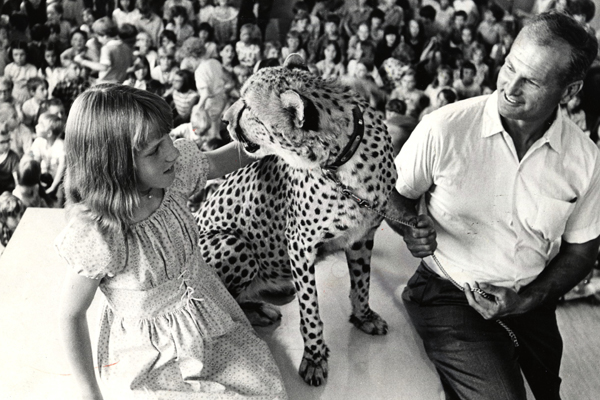The Waskahegan Trail Association has been providing refreshments at the Canadian Birkie (formerly the Canadian Birkebeiner) since the festival began in 1985. The event attracts both serious competitors and recreational skiers.
Gene Miskiw, one of the earliest volunteers, describes the work that was involved in keeping the participants safe and fueled up. He also describes some deathly-dangerous moments and some of the interesting personalities that stopped at our food station.
Setting up the station
The first Birkebeiner was held in Devon. The route took the participants to the Edmonton river valley. But after a few years of dealing with minimal snow conditions it was moved to Strathcona County and held in what was then the Blackfoot Grazing Lease. Here there was plenty of space and ideal conditions in the forested area for good skiing.
The Waskahegan Trail Association operated one of the refreshment and First Aid stations from day one. I provided snowmobile support for the event and our station. The snowmobiles were very useful in ferrying supplies to our station and ferrying people in and out, especially people who had to drop out at our station and be taken to the road where they would be picked up and driven to the finish line.

In the first few years, we accessed our station from Wanisan Lake, which was a long drive. Many of our volunteers chose to ski out to it, and others caught a ride in or out on the snowmobiles. In every case someone had to unlock a gate for us to access the grazing lease. When we went out to our station in the morning, we had to break the trail with our loaded sleds, which was often very difficult considering we were hauling in all our supplies.
The Birkie people would deliver tents, firewood, and a picnic table or two for our station, but we had to bring in everything else. And then take out everything we brought in except the water.
The biggest challenge was getting enough water to the site. Oscar Zawalsky built a great sled for the purpose of handling and containing the water in plastic jugs. That made that part of the job immensely easier, although we still had to contend with the deep soft snow.

Besides the water, we had to bring in the camp stoves and propane tanks, cases of Gatorade and boxes of fresh fruit and muffins plus serving trays and cooking pots. All this had to come in with us because it would freeze if delivered early.
“Something’s amiss”
One year at our station east of Wanisan, we expected to be done early in the afternoon according to the schedule. When we were quite sure that we were done and the last skiers had passed through, we started packing up and dumping our water when to our great surprise a group of professional skiers swept in. The international pros were always the first through our station so we knew that this was an anomaly. They and we were not sure what went wrong but we knew that something had gone amiss.
I drove up the trail to check it out and found that at a point where the 55k trails and the 30k trails adjoined, someone had crossed and knocked down the barriers between them. This created a great deal of confusion for any skiers coming later, many of whom took the trail they had not intended.
Snowmobile to the rescue
Another year, as we were starting to load up at Wanisan Lake after the event, we were joined by a number of Provincial Parks people also coming out. We learned, in talking to them, that one of their large twin track snowmobiles had broken down somewhere back in the grazing lease. We were just starting to load my heavy duty sled so we pulled it off again and offered to go back with them to pick it up. They led me in to where it had broken down, loaded it, and we brought it out for them.
We always had excellent relations with the Parks people and I think the Birkie became sort of an annual reunion for them as they came from various parks across the province where many of them had worked together in previous years.
Last Chance Station
After a few years we were assigned to a site called Last Chance, and we have kept that station ever since. It was 7km before the finish line. The first year it did not have a shelter. And that year was one of the coldest years we ever experienced for the Birkie. We had tents with feeble, smoky heaters for shelter and warmth but they were totally inadequate for the temperature.
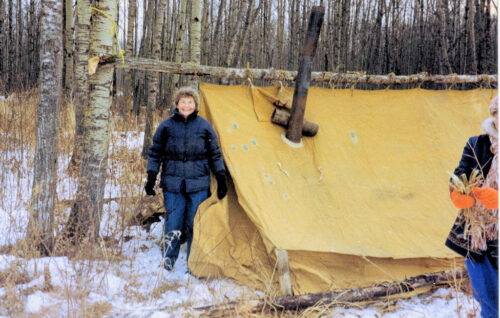
We had many evacuees that year, one of which I picked up off the trail after we had reports that she was off her skis. I bundled her up in a sleeping bag and first aid blankets on my rescue sled and tied her skis on top of her to bring her to our station. She was under-dressed and hypothermic and the First Aid people were unable to warm her up in the poorly heated tents.
The medical team arranged for STARS to pick her up off Wanisan Lake. She was bundled up again in blankets on my rescue sled and I ferried her out to the lake where the STARS helicopter met us as scheduled.
We were joined by another, less serious hypothermic from Islet Lake, who was ferried out from the road by another snowmobile team.
On that day there were a few other snowmobile teams in the area. Whenever we met another on the trail we would stop to exchange information and check each other’s faces for signs of frostbite.
I came prepared with extra scarves and gave them, and sometimes my helmet with a visor, to my passengers for the trip out if they could use them. They were, after all, dressed for skiing and not for riding. My sled was a Santa-type of sled that was most useful for hauling passengers. Evacuees were usually bundled up in First Aid blankets to keep them warm.
Provincial Parks and Meadow Shelter
Around this time, Provincial Parks was getting involved in the operation of the grazing lease as a recreational area. They built a lovely shelter (Meadow Shelter) at the Last Chance location and we used it in the Birkie.
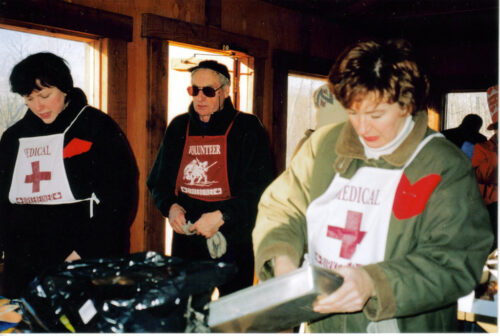
What a luxury that was for our volunteers and for the participants who were able, if they wished, to take a long leisurely break in the toasty interior of the shelter and enjoy hot chocolate and snacks.
Provincial Parks Support
Provincial Parks started providing more support for the Birkie. One year they delivered a tank of water to the Last Chance site. This made our lives immediately much easier as that was the heaviest and most challenging item for us to bring in.
There was a year they must have delivered the water very early in the morning because we found, when we got there, that the spigot had frozen up. We boiled up some water that we were able to scoop out of the top of the tank and poured it over the spigot, which released right away.
Every year Provincial Parks provided more and more support. After a few years they provided all the transportation we required for the Birkie, thereby gradually rendering our snowmobiles unnecessary, if not unwelcome. We all had the pleasure of riding to our site and back in comfortable Government trucks. From then on, no private vehicles were permitted beyond the staging area.
Skiers we have met
There were hundreds of stories that came out of the Birkie events. I recall one fellow who stopped briefly at Last Chance and asked me to get a screwdriver out of his pack and tighten the screws on his bindings. The screws were pretty well stripped and could not be tightened but he was determined to finish. He asked me to get some black tape out of his pack to wrap around the ski to help support the bindings but it snapped as soon as he flexed. We tried some light copper wire that he had but then he had no glide at all with that, so when we assured him that we would deliver his faulty ski to the Waskahegan Staging area for him, he left on one ski, determined to finish the last 7km.
We frequently would have a blind skier participating with a companion in one of the shorter events.
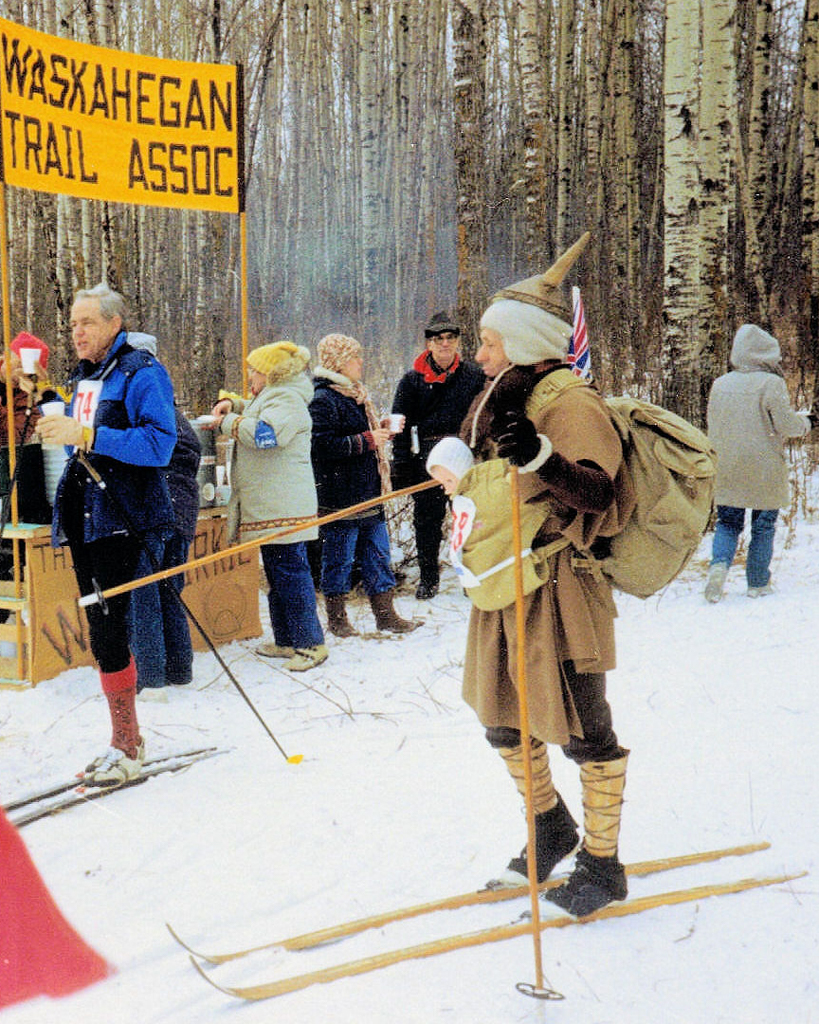

One year we were getting reports of three women in trouble on the 15k route but we left them alone until we heard that one of them was off her skis about 3k back. I left with my snowmobile to pick them up and found them just around the corner less than 1k back. One of the ladies had pulled her hamstrings and very gingerly got on my machine behind me and one of her companions rode in the sled with both pairs of skis while the other skied out on her own. They sat around in the shelter for hours socializing, drinking coffee and hot chocolate and smoking.
Later in the afternoon we encouraged them to let me take them out to the road where they could get a ride to Waskahegan Staging area because very soon we would have to ferry out any others who were getting off the trail, along with the First Aid team, the communications guy, our own volunteers, and all our stuff as we cleared out after the race ended.
Lloyd McCaffrey was our sweep on the 55km route. He would be the last off the trail to ensure that no-one was left out there. These ladies finally got their stuff together and we loaded up as we did when they arrived. The one lady was setting out to ski out to the finish line and the other two rode as before but the one riding in the sled had her cup of coffee and a cigarette as she boarded. They were really having a great time despite the pain that the one was suffering. They posed for photos before we left amid much merriment. All of our volunteers taking a break or cutting up fruit in the shelter got a chuckle out of their presence that day.
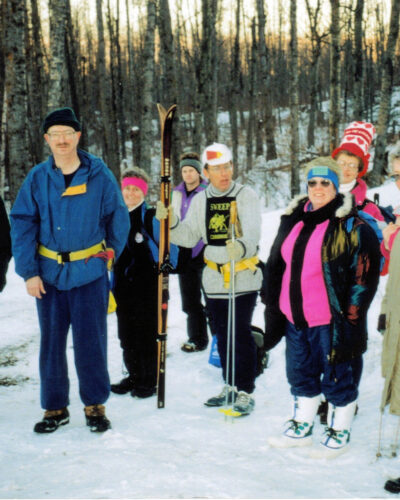
Lloyd McCaffrey (centre) with Rob Faulds and Helen Whitson (pink headband) on his left (1998)
Yardley Jones [Edmonton Journal political cartoonist] and Nick Lees [Edmonton Journal columnist] would ski the Birkie every year and they always stopped to socialize with us. Nick Lees, who was younger, would come by before Yardley did. Nick would inevitably advise us, upon leaving, to be sure to tell Yardley that when he came through that he was among the highly competitive group of international frontrunners, when in fact that group came through much earlier.

The Waskahegan Trail Association continues to volunteer at each Birkie Event. If you are interested in helping out at the next Birkie, contact us at info@waskahegantrail.ca
Photos are courtesy of Gene Miskiw. For more photos, visit the album on Flickr.
